Highly Stable Lithium Metal Anode Constructed by Three-Dimensional Lithiophilic Materials
Abstract
:1. Introduction
2. 3D Metal-Based Materials to Stabilize Lithium Anode
2.1. 3D Lithiophilic Metal Collector
2.2. 3D Lithium Alloy and 3D Metal/Lithium Complex Anode
3. 3D Lithiophilic Carbon Materials
4. 3D Organic Polymer Materials
5. Conclusions
Author Contributions
Funding
Institutional Review Board Statement
Informed Consent Statement
Data Availability Statement
Conflicts of Interest
References
- Cheng, X.B.; Zhang, R.; Zhao, C.Z.; Zhang, Q. Toward Safe Lithium Metal Anode in Rechargeable Batteries. Chem. Rev. 2017, 117, 10403–10473. [Google Scholar] [CrossRef]
- Zhang, J.G.; Xu, W.; Xiao, J.; Cao, X.; Liu, J. Lithium Metal Anodes with Nonaqueous Electrolytes. Chem. Rev. 2020, 120, 13312–13348. [Google Scholar] [CrossRef]
- Gu, X.; Lai, C. One dimensional nanostructures contribute better Li–S and Li–Se batteries: Progress, challenges and perspectives. Energy Stor. Mater. 2019, 23, 190–224. [Google Scholar] [CrossRef]
- Zuo, J.-H.; Gong, Y.-J. Applications of transition-metal sulfides in the cathodes of lithium–sulfur batteries. Tungsten 2020, 2, 134–146. [Google Scholar] [CrossRef]
- Ali, A.; Liang, F.; Zhu, J.; Shen, P.K. The role of graphene in rechargeable lithium batteries: Synthesis, functionalisation and perspectives. Nano Mater. Sci. 2022; in press. [Google Scholar] [CrossRef]
- Sun, Y.-Q.; Fu, W.; Hu, Y.-X.; Vaughan, J.; Wang, L.-Z. The role of tungsten-related elements for improving the electrochemical performances of cathode materials in lithium ion batteries. Tungsten 2021, 3, 245–259. [Google Scholar] [CrossRef]
- Cheng, Y.; Chen, J.; Chen, Y.; Ke, X.; Li, J.; Yang, Y.; Shi, Z. Lithium Host: Advanced Architecture Components for Lithium Metal Anode. Energy Stor. Mater. 2021, 38, 276–298. [Google Scholar]
- Lang, J.; Qi, L.; Luo, Y.; Wu, H. High performance lithium metal anode: Progress and prospects. Energy Stor. Mater. 2017, 7, 115–129. [Google Scholar] [CrossRef]
- Yang, H.; Guo, C.; Naveed, A.; Lei, J.; Yang, J.; Nuli, Y.; Wang, J. Recent progress and perspective on lithium metal anode protection. Energy Stor. Mater. 2018, 14, 199–221. [Google Scholar] [CrossRef]
- Yang, C.; Fu, K.; Zhang, Y.; Hitz, E.; Hu, L. Protected Lithium-Metal Anodes in Batteries: From Liquid to Solid. Adv. Mater. 2017, 29, 1701169. [Google Scholar] [CrossRef]
- Zhang, R.; Li, N.W.; Cheng, X.B.; Yin, Y.X.; Zhang, Q.; Guo, Y.G. Advanced Micro/Nanostructures for Lithium Metal Anodes. Adv. Sci. 2017, 4, 1600445. [Google Scholar] [CrossRef] [PubMed]
- Moorthy, B.; Ponraj, R.; Yun, J.H.; Wang, J.E.; Kim, D.J.; Kim, D.K. Ice-Templated Free-Standing Reduced Graphene Oxide for Dendrite-Free Lithium Metal Batteries. ACS Appl. Energy Mater. 2020, 3, 11053–11060. [Google Scholar] [CrossRef]
- Dai, H.; Gu, X.; Dong, J.; Wang, C.; Lai, C.; Sun, S. Stabilizing lithium metal anode by octaphenyl polyoxyethylene-lithium complexation. Nat. Commun. 2020, 11, 643. [Google Scholar] [CrossRef] [PubMed] [Green Version]
- Cheng, X.-B.; Zhao, C.-Z.; Yao, Y.-X.; Liu, H.; Zhang, Q. Recent Advances in Energy Chemistry between Solid-State Electrolyte and Safe Lithium-Metal Anodes. Chem 2019, 5, 74–96. [Google Scholar] [CrossRef] [Green Version]
- Wei, W.-Q.; Liu, B.-Q.; Gan, Y.-Q.; Ma, H.-J.; Cui, D.-W. Protecting lithium metal anode in all-solid-state batteries with a composite electrolyte. Rare Met. 2020, 40, 409–416. [Google Scholar] [CrossRef]
- Jin, S.; Jiang, Y.; Ji, H.; Yu, Y. Advanced 3D Current Collectors for Lithium-Based Batteries. Adv. Mater. 2018, 30, e1802014. [Google Scholar] [CrossRef]
- Park, S.; Jin, H.J.; Yun, Y.S. Advances in the Design of 3D-Structured Electrode Materials for Lithium-Metal Anodes. Adv. Mater. 2020, 32, 2002193. [Google Scholar] [CrossRef]
- Wu, N.; Zhang, Q.-Y.; Guo, Y.-J.; Zhou, L.; Zhang, L.-J.; Wu, M.-X.; Wang, W.-P.; Yin, Y.-X.; Sheng, P.; Xin, S. Boron-doped three-dimensional MXene host for durable lithium-metal anode. Rare Met. 2022, 41, 2217–2222. [Google Scholar] [CrossRef]
- Moorthy, B.; Kim, J.-H.; Lee, H.-W.; Kim, D.K. Vertically aligned carbon nanotubular structure for guiding uniform lithium deposition via capillary pressure as stable metallic lithium anodes. Energy Stor. Mater. 2020, 24, 602–609. [Google Scholar] [CrossRef]
- Sun, Y.; Zhao, C.; Adair, K.R.; Zhao, Y.; Goncharova, L.V.; Liang, J.; Wang, C.; Li, J.; Li, R.; Cai, M.; et al. Regulated lithium plating and stripping by a nano-scale gradient inorganic–organic coating for stable lithium metal anodes. Energy Environ. Sci. 2021, 14, 4085–4094. [Google Scholar] [CrossRef]
- Pathak, R.; Zhou, Y.; Qiao, Q. Recent Advances in Lithiophilic Porous Framework toward Dendrite-Free Lithium Metal Anode. Appl. Sci. 2020, 10, 4185. [Google Scholar] [CrossRef]
- Gu, X.; Dong, J.; Lai, C. Li-containing alloys beneficial for stabilizing lithium anode: A review. Eng. Rep. 2020, 3, e12339. [Google Scholar] [CrossRef]
- Wang, S.H.; Yue, J.; Dong, W.; Zuo, T.T.; Li, J.Y.; Liu, X.; Zhang, X.D.; Liu, L.; Shi, J.L.; Yin, Y.X.; et al. Tuning wettability of molten lithium via a chemical strategy for lithium metal anodes. Nat. Commun. 2019, 10, 4930. [Google Scholar] [CrossRef] [PubMed] [Green Version]
- Song, Y.-X.; Lu, W.-Y.; Chen, Y.-J.; Yang, H.; Wu, C.; Wei, W.-F.; Chen, L.-B.; Ouyang, X.-P. Coating highly lithiophilic Zn on Cu foil for high-performance lithium metal batteries. Rare Met. 2021, 41, 1255–1264. [Google Scholar] [CrossRef]
- Ma, T.; Wang, R.; Jin, S.; Zheng, S.; Li, L.; Shi, J.; Cai, Y.; Liang, J.; Tao, Z. Functionalized Boron Nitride-Based Modification Layer as Ion Regulator toward Stable Lithium Anode at High Current Densities. ACS Appl. Mater. Interfaces 2021, 13, 391–399. [Google Scholar] [CrossRef]
- Luo, Y.; Li, T.; Zhang, H.; Yu, Y.; Hussain, A.; Yan, J.; Zhang, H.; Li, X. New insights into the formation of silicon–oxygen layer on lithium metal anode via in situ reaction with tetraethoxysilane. J. Energy Chem. 2021, 56, 14–22. [Google Scholar] [CrossRef]
- Jia, W.; Wang, Z.; Li, J.; Yu, X.; Wei, Y.; Yao, Z.; Liu, Y.; Wang, Y.; Zhou, A.; Zou, W.; et al. A dual-phase Li–Ca alloy with a patternable and lithiophilic 3D framework for improving lithium anode performance. J. Mater. Chem. A 2019, 7, 22377–22384. [Google Scholar] [CrossRef]
- Tang, L.; Zhang, R.; Zhang, X.; Zhao, N.; Shi, C.; Liu, E.; Ma, L.; Luo, J.; He, C. ZnO nanoconfined 3D porous carbon composite microspheres to stabilize lithium nucleation/growth for high-performance lithium metal anodes. J. Mater. Chem. A 2019, 7, 19442–19452. [Google Scholar] [CrossRef]
- Ye, Y.; Liu, Y.; Wu, J.; Yang, Y. Lithiophilic Li-Zn alloy modified 3D Cu foam for dendrite-free lithium metal anode. J. Power Sources 2020, 472, 228520. [Google Scholar] [CrossRef]
- Wondimkun, Z.T.; Tegegne, W.A.; Shi-Kai, J.; Huang, C.-J.; Sahalie, N.A.; Weret, M.A.; Hsu, J.-Y.; Hsieh, P.-L.; Huang, Y.-S.; Wu, S.-H.; et al. Highly-lithiophilic Ag@PDA-GO Film to Suppress Dendrite Formation on Cu Substrate in Anode-Free Lithium Metal Batteries. Energy Stor. Mater. 2021, 35, 334–344. [Google Scholar] [CrossRef]
- Luo, L.; Li, J.; Yaghoobnejad Asl, H.; Manthiram, A. A 3D Lithiophilic Mo2N-Modified Carbon Nanofiber Architecture for Dendrite-Free Lithium-Metal Anodes in a Full Cell. Adv. Mater. 2019, 31, 1904537. [Google Scholar] [CrossRef]
- Zhang, C.; Lyu, R.; Lv, W.; Li, H.; Jiang, W.; Li, J.; Gu, S.; Zhou, G.; Huang, Z.; Zhang, Y.; et al. A Lightweight 3D Cu Nanowire Network with Phosphidation Gradient as Current Collector for High-Density Nucleation and Stable Deposition of Lithium. Adv. Mater. 2019, 31, 1904991. [Google Scholar] [CrossRef]
- Liu, T.; Chen, X.; Zhan, C.; Cao, X.; Wang, Y.; Liu, J.H. Selective Lithium Deposition on 3D Porous Heterogeneous Lithiophilic Skeleton for Ultrastable Lithium Metal Anodes. ChemNanoMat 2020, 6, 1200–1207. [Google Scholar] [CrossRef]
- Yang, C.P.; Yin, Y.X.; Zhang, S.F.; Li, N.W.; Guo, Y.G. Accommodating lithium into 3D current collectors with a submicron skeleton towards long-life lithium metal anodes. Nat. Commun. 2015, 6, 8058. [Google Scholar] [CrossRef] [Green Version]
- Zhang, W.; Jin, H.; Xu, C.; Zhao, S.; Du, Y.; Zhang, J. Diffusion couples Cu-X (X = Sn, Zn, Al) derived 3D porous current collector for dendrite-free lithium metal battery. J. Power Sources 2019, 440, 227142. [Google Scholar] [CrossRef]
- Xu, Y.; Menon, A.S.; Harks, P.P.R.M.L.; Hermes, D.C.; Haverkate, L.A.; Unnikrishnan, S.; Mulder, F.M. Honeycomb-like porous 3D nickel electrodeposition for stable Li and Na metal anodes. Energy Stor. Mater. 2018, 12, 69–78. [Google Scholar] [CrossRef]
- Lu, L.L.; Ge, J.; Yang, J.N.; Chen, S.M.; Yao, H.B.; Zhou, F.; Yu, S.H. Free-Standing Copper Nanowire Network Current Collector for Improving Lithium Anode Performance. Nano Lett. 2016, 16, 4431–4437. [Google Scholar] [CrossRef] [PubMed]
- Zhang, X.; Wang, A.; Lv, R.; Luo, J. A corrosion-resistant current collector for lithium metal anodes. Energy Stor. Mater. 2019, 18, 199–204. [Google Scholar] [CrossRef]
- Yan, K.; Lu, Z.; Lee, H.-W.; Xiong, F.; Hsu, P.-C.; Li, Y.; Zhao, J.; Chu, S.; Cui, Y. Selective deposition and stable encapsulation of lithium through heterogeneous seeded growth. Nat. Energy 2016, 1, 1–8. [Google Scholar] [CrossRef]
- Fan, H.; Gao, C.; Dong, Q.; Hong, B.; Fang, Z.; Hu, M.; Lai, Y. Silver sites guide spatially homogeneous plating of lithium metal in 3D host. J. Electroanal. Chem. 2018, 824, 175–180. [Google Scholar] [CrossRef]
- Chen, J.; Xiang, J.; Chen, X.; Yuan, L.; Li, Z.; Huang, Y. Li2S-based anode-free full batteries with modified Cu current collector. Energy Stor. Mater. 2020, 30, 179–186. [Google Scholar] [CrossRef]
- Huang, S.; Zhang, W.; Ming, H.; Cao, G.; Fan, L.Z.; Zhang, H. Chemical Energy Release Driven Lithiophilic Layer on 1 m2 Commercial Brass Mesh toward Highly Stable Lithium Metal Batteries. Nano Lett. 2019, 19, 1832–1837. [Google Scholar] [CrossRef] [PubMed]
- Wu, Y.; Zhang, Y.; Liu, Y.; Feng, J. In Situ-Formed Dual-Conductive Protecting Layer for Dendrite-Free Li Metal Anodes in All-Solid-State Batteries. Energy Technol. 2021, 9, 2100087. [Google Scholar] [CrossRef]
- Chen, X.-R.; Chen, X.; Yan, C.; Zhang, X.-Q.; Zhang, Q.; Huang, J.-Q. Role of Lithiophilic Metal Sites in Lithium Metal Anodes. Energy Fuels 2021, 35, 12746–12752. [Google Scholar] [CrossRef]
- Wu, C.; Huang, H.; Lu, W.; Wei, Z.; Ni, X.; Sun, F.; Qing, P.; Liu, Z.; Ma, J.; Wei, W.; et al. Mg Doped Li-LiB Alloy with in Situ Formed Lithiophilic LiB Skeleton for Lithium Metal Batteries. Adv. Sci. 2020, 7, 1902643. [Google Scholar] [CrossRef]
- Liu, S.; Ma, Y.; Zhou, Z.; Lou, S.; Huo, H.; Zuo, P.; Wang, J.; Du, C.; Yin, G.; Gao, Y. Inducing uniform lithium nucleation by integrated lithium-rich li-in anode with lithiophilic 3D framework. Energy Stor. Mater. 2020, 33, 423–431. [Google Scholar] [CrossRef]
- Guo, F.; Wu, C.; Chen, H.; Zhong, F.; Ai, X.; Yang, H.; Qian, J. Dendrite-free lithium deposition by coating a lithiophilic heterogeneous metal layer on lithium metal anode. Energy Stor. Mater. 2020, 24, 635–643. [Google Scholar] [CrossRef]
- Chen, T.; Meng, F.; Zhang, Z.; Liang, J.; Hu, Y.; Kong, W.; Zhang, X.L.; Jin, Z. Stabilizing lithium metal anode by molecular beam epitaxy grown uniform and ultrathin bismuth film. Nano Energy 2020, 76, 105068. [Google Scholar] [CrossRef]
- Song, R.; Ge, Y.; Wang, B.; Lv, Q.; Wang, F.; Ruan, T.; Wang, D.; Dou, S.; Liu, H. A new reflowing strategy based on lithiophilic substrates towards smooth and stable lithium metal anodes. J. Mater. Chem. A 2019, 7, 18126–18134. [Google Scholar] [CrossRef]
- Liu, T.; Hu, Q.; Li, X.; Tan, L.; Yan, G.; Wang, Z.; Guo, H.; Liu, Y.; Wu, Y.; Wang, J. Lithiophilic Ag/Li composite anodes via a spontaneous reaction for Li nucleation with a reduced barrier. J. Mater. Chem. A 2019, 7, 20911–20918. [Google Scholar] [CrossRef]
- Kong, L.L.; Wang, L.; Ni, Z.C.; Liu, S.; Li, G.R.; Gao, X.P. Lithium–Magnesium Alloy as a Stable Anode for Lithium–Sulfur Battery. Adv. Funct. Mater. 2019, 29, 1808756. [Google Scholar] [CrossRef]
- Krauskopf, T.; Mogwitz, B.; Rosenbach, C.; Zeier, W.G.; Janek, J. Diffusion Limitation of Lithium Metal and Li–Mg Alloy Anodes on LLZO Type Solid Electrolytes as a Function of Temperature and Pressure. Adv. Energy Mater. 2019, 9, 1902568. [Google Scholar] [CrossRef] [Green Version]
- Zhang, Y.; Chandran, K.S.R.; Jagannathan, M.; Bilheux, H.Z.; Bilheux, J.C. The Nature of Electrochemical Delithiation of Li-Mg Alloy Electrodes: Neutron Computed Tomography and Analytical Modeling of Li Diffusion and Delithiation Phenomenon. J. Electrochem. Soc. 2017, 164, A28–A38. [Google Scholar] [CrossRef]
- Richardson, T.J.; Chen, G. Solid solution lithium alloy cermet anodes. J. Power Sources 2007, 174, 810–812. [Google Scholar] [CrossRef] [Green Version]
- Shi, Z.; Liu, M.; Naik, D.; Gole, J.L. Electrochemical properties of Li-Mg alloy electrodes for lithium batteries. J. Power Sources 2001, 92, 70–80. [Google Scholar] [CrossRef]
- Xu, Y.; Zhao, S.; Zhou, G.; Chen, W.; Zhou, F.; Rong, Z.; Wu, Y.; Li, J.; Guo, J.; Zhang, Y. Solubility-Dependent Protective Effects of Binary Alloys for Lithium Anode. ACS Appl. Energy Mater. 2020, 3, 2278–2284. [Google Scholar] [CrossRef]
- Jin, C.; Sheng, O.; Luo, J.; Yuan, H.; Fang, C.; Zhang, W.; Huang, H.; Gan, Y.; Xia, Y.; Liang, C.; et al. 3D lithium metal embedded within lithiophilic porous matrix for stable lithium metal batteries. Nano Energy 2017, 37, 177–186. [Google Scholar] [CrossRef]
- Wu, S.; Zhang, Z.; Lan, M.; Yang, S.; Cheng, J.; Cai, J.; Shen, J.; Zhu, Y.; Zhang, K.; Zhang, W. Lithiophilic Cu-CuO-Ni Hybrid Structure: Advanced Current Collectors toward Stable Lithium Metal Anodes. Adv. Mater. 2018, 30, 1705830. [Google Scholar] [CrossRef]
- Zhang, C.; Lv, W.; Zhou, G.; Huang, Z.; Zhang, Y.; Lyu, R.; Wu, H.; Yun, Q.; Kang, F.; Yang, Q.-H. Vertically Aligned Lithiophilic CuO Nanosheets on a Cu Collector to Stabilize Lithium Deposition for Lithium Metal Batteries. Adv. Energy Mater. 2018, 8, 1703404. [Google Scholar] [CrossRef]
- Zhang, H.; Liao, X.; Guan, Y.; Xiang, Y.; Li, M.; Zhang, W.; Zhu, X.; Ming, H.; Lu, L.; Qiu, J.; et al. Lithiophilic-lithiophobic gradient interfacial layer for a highly stable lithium metal anode. Nat. Commun. 2018, 9, 3729. [Google Scholar] [CrossRef] [Green Version]
- Lu, W.; Wu, C.; Wei, W.; Ma, J.; Chen, L.; Chen, Y. Lithiophilic NiO hexagonal plates decorated Ni collector guiding uniform lithium plating for stable lithium metal anode. J. Mater. Chem. A 2019, 7, 24262–24270. [Google Scholar] [CrossRef]
- Tantratian, K.; Cao, D.; Abdelaziz, A.; Sun, X.; Sheng, J.; Natan, A.; Chen, L.; Zhu, H. Stable Li Metal Anode Enabled by Space Confinement and Uniform Curvature through Lithiophilic Nanotube Arrays. Adv. Energy Mater. 2019, 10, 1902819. [Google Scholar] [CrossRef]
- Xue, P.; Sun, C.; Li, H.; Liang, J.; Lai, C. Superlithiophilic Amorphous SiO2-TiO2 Distributed into Porous Carbon Skeleton Enabling Uniform Lithium Deposition for Stable Lithium Metal Batteries. Adv. Sci. 2019, 6, 1900943. [Google Scholar] [CrossRef] [PubMed] [Green Version]
- Gong, Z.; Lian, C.; Wang, P.; Huang, K.; Zhu, K.; Ye, K.; Yan, J.; Wang, G.; Cao, D. Lithiophilic Cu-Li2O matrix on a Cu Collector to Stabilize Lithium Deposition for Lithium Metal Batteries. Energy Environ. Mater. 2021, 5, 1270–1277. [Google Scholar] [CrossRef]
- Lu, L.Q.; Pei, Y.T. Interfacial modification by lithiophilic oxide facilitating uniform and thin solid electrolyte interphase towards stable lithium metal anodes. Mater. Today Energy 2021, 21, 100748. [Google Scholar] [CrossRef]
- Qiu, X.; Yu, M.; Fan, G.; Liu, J.; Wang, Y.; Zhao, K.; Ding, J.; Cheng, F. Growing Nanostructured CuO on Copper Foil via Chemical Etching to Upgrade Metallic Lithium Anode. ACS Appl. Mater. Interfaces 2021, 13, 6367–6374. [Google Scholar] [CrossRef]
- Yu, B.; Fan, Y.; Mateti, S.; Kim, D.; Zhao, C.; Lu, S.; Liu, X.; Rong, Q.; Tao, T.; Tanwar, K.K.; et al. An Ultra-Long-Life Flexible Lithium-Sulfur Battery with Lithium Cloth Anode and Polysulfone-Functionalized Separator. ACS Nano 2021, 15, 1358–1369. [Google Scholar] [CrossRef]
- Cai, Y.; Qin, B.; Li, C.; Si, X.; Cao, J.; Zheng, X.; Qi, J. Stable lithium metal anode achieved by shortening diffusion path on solid electrolyte interface derived from Cu2O lithiophilic layer. Chem. Eng. J. 2022, 433, 133689. [Google Scholar] [CrossRef]
- Liu, Y.; Sun, J.; Hu, X.; Li, Y.; Du, H.; Wang, K.; Du, Z.; Gong, X.; Ai, W.; Huang, W. Lithiophilic sites dependency of lithium deposition in Li metal host anodes. Nano Energy 2022, 94, 106883. [Google Scholar] [CrossRef]
- Wang, D.; Lv, D.; Liu, H.; Yang, J.; Qian, Y.; Chen, Z. Forming Solid-Electrolyte Interphases with Rich Grain Boundaries on 3D Lithiophilic Skeleton for Low-Temperature Lithium Metal Batteries. Energy Stor. Mater. 2022, 49, 454–462. [Google Scholar] [CrossRef]
- Shi, P.; Li, T.; Zhang, R.; Shen, X.; Cheng, X.B.; Xu, R.; Huang, J.Q.; Chen, X.R.; Liu, H.; Zhang, Q. Lithiophilic LiC6 Layers on Carbon Hosts Enabling Stable Li Metal Anode in Working Batteries. Adv. Mater. 2019, 31, 1807131. [Google Scholar] [CrossRef] [PubMed]
- Chen, H.; Yang, Y.; Boyle, D.T.; Jeong, Y.K.; Xu, R.; de Vasconcelos, L.S.; Huang, Z.; Wang, H.; Wang, H.; Huang, W.; et al. Free-standing ultrathin lithium metal–graphene oxide host foils with controllable thickness for lithium batteries. Nat. Energy 2021, 6, 790–798. [Google Scholar] [CrossRef]
- Huang, G.; Han, J.; Zhang, F.; Wang, Z.; Kashani, H.; Watanabe, K.; Chen, M. Lithiophilic 3D Nanoporous Nitrogen-Doped Graphene for Dendrite-Free and Ultrahigh-Rate Lithium-Metal Anodes. Adv. Mater. 2019, 31, 1805334. [Google Scholar] [CrossRef]
- Yu, L.; Su, Q.; Li, B.; Liu, W.; Zhang, M.; Ding, S.; Du, G.; Xu, B. Bio-inspired lotus root-like 3D multichannel carbon hosts for stable lithium metal anodes. Electrochim. Acta 2020, 362, 137130. [Google Scholar] [CrossRef]
- Jiang, Z.; Meng, C.; Chen, G.; Yuan, R.; Li, A.; Zhou, J.; Chen, X.; Song, H. Lithiophilic onion-like carbon spheres as lithium metal uniform deposition host. J. Colloid Interf. Sci. 2022, 627, 783–792. [Google Scholar] [CrossRef]
- Noh, J.; Tan, J.; Yadav, D.R.; Wu, P.; Xie, K.Y.; Yu, C. Understanding of Lithium Insertion into 3D Porous Carbon Scaffolds with Hybridized Lithiophobic and Lithiophilic Surfaces by In-Operando Study. Nano Lett. 2020, 20, 3681–3687. [Google Scholar] [CrossRef]
- Liang, Z.; Lin, D.; Zhao, J.; Lu, Z.; Liu, Y.; Liu, C.; Lu, Y.; Wang, H.; Yan, K.; Tao, X.; et al. Composite lithium metal anode by melt infusion of lithium into a 3D conducting scaffold with lithiophilic coating. Proc. Natl. Acad. Sci. USA 2016, 113, 2862–2867. [Google Scholar] [CrossRef] [PubMed] [Green Version]
- Zhang, R.; Cheng, X.B.; Zhao, C.Z.; Peng, H.J.; Shi, J.L.; Huang, J.Q.; Wang, J.; Wei, F.; Zhang, Q. Conductive Nanostructured Scaffolds Render Low Local Current Density to Inhibit Lithium Dendrite Growth. Adv. Mater. 2016, 28, 2155–2162. [Google Scholar] [CrossRef]
- Lin, D.; Liu, Y.; Liang, Z.; Lee, H.W.; Sun, J.; Wang, H.; Yan, K.; Xie, J.; Cui, Y. Layered reduced graphene oxide with nanoscale interlayer gaps as a stable host for lithium metal anodes. Nat. Nanotechnol. 2016, 11, 626–632. [Google Scholar] [CrossRef]
- Zhang, Y.; Luo, W.; Wang, C.; Li, Y.; Chen, C.; Song, J.; Dai, J.; Hitz, E.M.; Xu, S.; Yang, C.; et al. High-capacity, low-tortuosity, and channel-guided lithium metal anode. Proc. Natl. Acad. Sci. USA 2017, 114, 3584–3589. [Google Scholar] [CrossRef] [Green Version]
- Chen, X.; Chen, X.-R.; Hou, T.-Z.; Li, B.-Q.; Cheng, X.-B.; Zhang, R.; Zhang, Q. Lithiophilicity chemistry of heteroatom-doped carbon to guide uniform lithium nucleation in lithium metal anodes. Sci. Adv. 2019, 5, eaau7728. [Google Scholar] [CrossRef]
- Fang, Y.; Zeng, Y.; Jin, Q.; Lu, X.F.; Luan, D.; Zhang, X.; Lou, X.W.D. Nitrogen-Doped Amorphous Zn-Carbon Multichannel Fibers for Stable Lithium Metal Anodes. Angew. Chem. Int. Ed. 2021, 60, 8515–8520. [Google Scholar] [CrossRef]
- Zhang, R.; Chen, X.R.; Chen, X.; Cheng, X.B.; Zhang, X.Q.; Yan, C.; Zhang, Q. Lithiophilic Sites in Doped Graphene Guide Uniform Lithium Nucleation for Dendrite-Free Lithium Metal Anodes. Angew. Chem. Int. Ed. 2017, 56, 7764–7768. [Google Scholar] [CrossRef]
- Chen, L.; Chen, H.; Wang, Z.; Gong, X.; Chen, X.; Wang, M.; Jiao, S. Self-supporting lithiophilic N-doped carbon rod array for dendrite-free lithium metal anode. Chem. Eng. J. 2019, 363, 270–277. [Google Scholar] [CrossRef]
- Feng, X.; Wu, H.-H.; Gao, B.; Świętosławski, M.; He, X.; Zhang, Q. Lithiophilic N-doped carbon bowls induced Li deposition in layered graphene film for advanced lithium metal batteries. Nano Res. 2021, 15, 352–360. [Google Scholar] [CrossRef]
- Chen, X.R.; Li, B.Q.; Zhao, C.X.; Zhang, R.; Zhang, Q. Synergetic Coupling of Lithiophilic Sites and Conductive Scaffolds for Dendrite-Free Lithium Metal Anodes. Small Meth. 2019, 4, 1900177. [Google Scholar] [CrossRef]
- Niu, C.; Pan, H.; Xu, W.; Xiao, J.; Zhang, J.G.; Luo, L.; Wang, C.; Mei, D.; Meng, J.; Wang, X.; et al. Self-smoothing anode for achieving high-energy lithium metal batteries under realistic conditions. Nat. Nanotechnol. 2019, 14, 594–601. [Google Scholar] [CrossRef] [PubMed]
- Cheng, H.; Mao, Y.; Xie, J.; Lu, Y.; Zhao, X. Dendrite-Free Fluorinated Graphene/Lithium Anodes Enabling in Situ LiF Formation for High-Performance Lithium-Oxygen Cells. ACS Appl. Mater. Interfaces 2019, 11, 39737–39745. [Google Scholar] [CrossRef]
- Fan, L.; Zhuang, H.L.; Zhang, W.; Fu, Y.; Liao, Z.; Lu, Y. Stable Lithium Electrodeposition at Ultra-High Current Densities Enabled by 3D PMF/Li Composite Anode. Adv. Energy Mater. 2018, 8, 1703360. [Google Scholar] [CrossRef]
- Yan, Y.; Shu, C.; Zheng, R.; Li, M.; Ran, Z.; He, M.; Hu, A.; Zeng, T.; Xu, H.; Zeng, Y. Modulating Sand’s time by ion-transport-enhancement toward dendrite-free lithium metal anode. Nano Res. 2021, 15, 3150–3160. [Google Scholar] [CrossRef]
- Wang, D.; Liu, H.; Liu, F.; Ma, G.; Yang, J.; Gu, X.; Zhou, M.; Chen, Z. Phase-Separation-Induced Porous Lithiophilic Polymer Coating for High-Efficiency Lithium Metal Batteries. Nano Lett. 2021, 21, 4757–4764. [Google Scholar] [CrossRef]
- Li, N.; Ye, Q.; Zhang, K.; Yan, H.; Shen, C.; Wei, B.; Xie, K. Normalized Lithium Growth from the Nucleation Stage for Dendrite-Free Lithium Metal Anodes. Angew. Chem. Int. Ed. 2019, 58, 18246–18251. [Google Scholar] [CrossRef] [PubMed]
- Liu, Y.; Qin, X.; Zhang, S.; Zhang, L.; Kang, F.; Chen, G.; Duan, X.; Li, B. A scalable slurry process to fabricate a 3D lithiophilic and conductive framework for a high performance lithium metal anode. J. Mater. Chem. A 2019, 7, 13225–13233. [Google Scholar] [CrossRef]
- Jiang, J.; Pan, Z.; Kou, Z.; Nie, P.; Chen, C.; Li, Z.; Li, S.; Zhu, Q.; Dou, H.; Zhang, X.; et al. Lithiophilic polymer interphase anchored on laser-punched 3D holey Cu matrix enables uniform lithium nucleation leading to super-stable lithium metal anodes. Energy Stor. Mater. 2020, 29, 84–91. [Google Scholar] [CrossRef]
- Shi, P.; Liu, Z.-Y.; Zhang, X.-Q.; Chen, X.; Yao, N.; Xie, J.; Jin, C.-B.; Zhan, Y.-X.; Ye, G.; Huang, J.-Q.; et al. Polar interaction of polymer host–solvent enables stable solid electrolyte interphase in composite lithium metal anodes. J. Energy Chem. 2022, 64, 172–178. [Google Scholar] [CrossRef]
- Han, D.-D.; Liu, S.; Liu, Y.-T.; Zhang, Z.; Li, G.-R.; Gao, X.-P. Lithiophilic gel polymer electrolyte to stabilize the lithium anode for a quasi-solid-state lithium–sulfur battery. J. Mater. Chem. A 2018, 6, 18627–18634. [Google Scholar] [CrossRef]
- Shen, L.; Liu, X.; Dong, J.; Zhang, Y.; Xu, C.; Lai, C.; Zhang, S. Functional lithiophilic polymer modified separator for dendrite-free and pulverization-free lithium metal batteries. J. Energy Chem. 2021, 52, 262–268. [Google Scholar] [CrossRef]
- Li, S.; Huang, Y.; Luo, C.; Ren, W.; Yang, J.; Li, X.; Wang, M.; Cao, H. Stabilize lithium metal anode through constructing a lithiophilic viscoelastic interface based on hydroxypropyl methyl cellulose. Chem. Eng. J. 2020, 399, 125687. [Google Scholar] [CrossRef]
- Li, G.; Liu, Z.; Huang, Q.; Gao, Y.; Regula, M.; Wang, D.; Chen, L.-Q.; Wang, D. Stable metal battery anodes enabled by polyethylenimine sponge hosts by way of electrokinetic effects. Nat. Energy 2018, 3, 1076–1083. [Google Scholar] [CrossRef]
- Shi, P.; Zhang, X.Q.; Shen, X.; Zhang, R.; Liu, H.; Zhang, Q. A Review of Composite Lithium Metal Anode for Practical Applications. Adv. Mater. Technol. 2019, 5, 1900806. [Google Scholar] [CrossRef] [Green Version]
- Zhang, X.; Yang, Y.; Zhou, Z. Towards practical lithium-metal anodes. Chem. Soc. Rev. 2020, 49, 3040–3071. [Google Scholar] [CrossRef] [PubMed]
- Jin, L.-M.; Xing, G.-G.; Qin, N.; Lu, Y.-Y.; Zheng, J.-S.; Zhang, C.-M.; Zheng, J.P. An empirical model for high energy density lithium-(ion) batteries with ultra-thick electrodes. Tungsten 2022, 4, 1–8. [Google Scholar] [CrossRef]
- Xu, P.; Hu, X.; Liu, X.; Lin, X.; Fan, X.; Cui, X.; Sun, C.; Wu, Q.; Lian, X.; Yuan, R.; et al. A Lithium-Metal Anode with Ultra-High Areal Capacity (50 mAh cm−2) by Gridding Lithium Plating/Stripping. Energy Stor. Mater. 2021, 38, 190–199. [Google Scholar] [CrossRef]
- Lu, Q.; Jie, Y.; Meng, X.; Omar, A.; Mikhailova, D.; Cao, R.; Jiao, S.; Lu, Y.; Xu, Y. Carbon materials for stable Li metal anodes: Challenges, solutions, and outlook. Carbon Energy 2021, 3, 957–975. [Google Scholar] [CrossRef]
- Li, J.; Kong, Z.; Liu, X.; Zheng, B.; Fan, Q.H.; Garratt, E.; Schuelke, T.; Wang, K.; Xu, H.; Jin, H. Strategies to anode protection in lithium metal battery: A review. InfoMat 2021, 3, 1333–1363. [Google Scholar] [CrossRef]
- Zhan, Y.X.; Shi, P.; Ma, X.X.; Jin, C.B.; Zhang, Q.K.; Yang, S.J.; Li, B.Q.; Zhang, X.Q.; Huang, J.Q. Failure Mechanism of Lithiophilic Sites in Composite Lithium Metal Anode under Practical Conditions. Adv. Energy Mater. 2021, 12, 2103291. [Google Scholar] [CrossRef]
- Zhang, L.; Yang, T.; Du, C.; Liu, Q.; Tang, Y.; Zhao, J.; Wang, B.; Chen, T.; Sun, Y.; Jia, P.; et al. Lithium whisker growth and stress generation in an in situ atomic force microscope-environmental transmission electron microscope set-up. Nat. Nanotechnol. 2020, 15, 94–98. [Google Scholar] [CrossRef]
- Rong, G.; Zhang, X.; Zhao, W.; Qiu, Y.; Liu, M.; Ye, F.; Xu, Y.; Chen, J.; Hou, Y.; Li, W.; et al. Liquid-Phase Electrochemical Scanning Electron Microscopy for in Situ Investigation of Lithium Dendrite Growth and Dissolution. Adv. Mater. 2017, 29, 1606187. [Google Scholar] [CrossRef]
- Zhang, H.; Wang, D.; Shen, C. In-situ EC-AFM and ex-situ XPS characterization to investigate the mechanism of SEI formation in highly concentrated aqueous electrolyte for Li-ion batteries. Appl. Surf. Sci. 2020, 507, 145059. [Google Scholar] [CrossRef]
- Farahmandjou, M.; Zhao, S.; Lai, W.-H.; Sun, B.; Notten, P.H.L.; Wang, G. Oxygen redox chemistry in lithium-rich cathode materials for Li-ion batteries: Understanding from atomic structure to nano-engineering. Nano Mater. Sci. 2022; in press. [Google Scholar] [CrossRef]

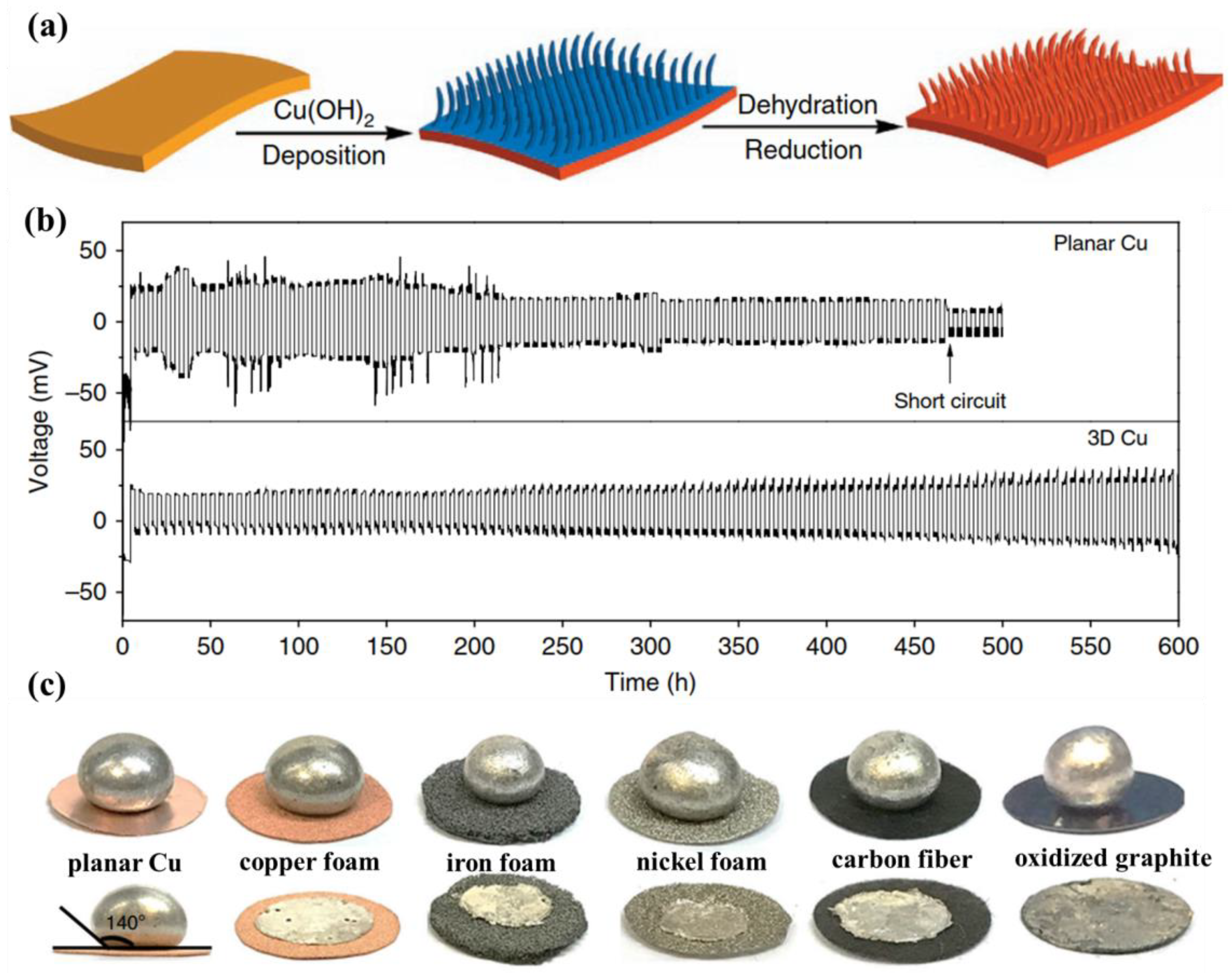
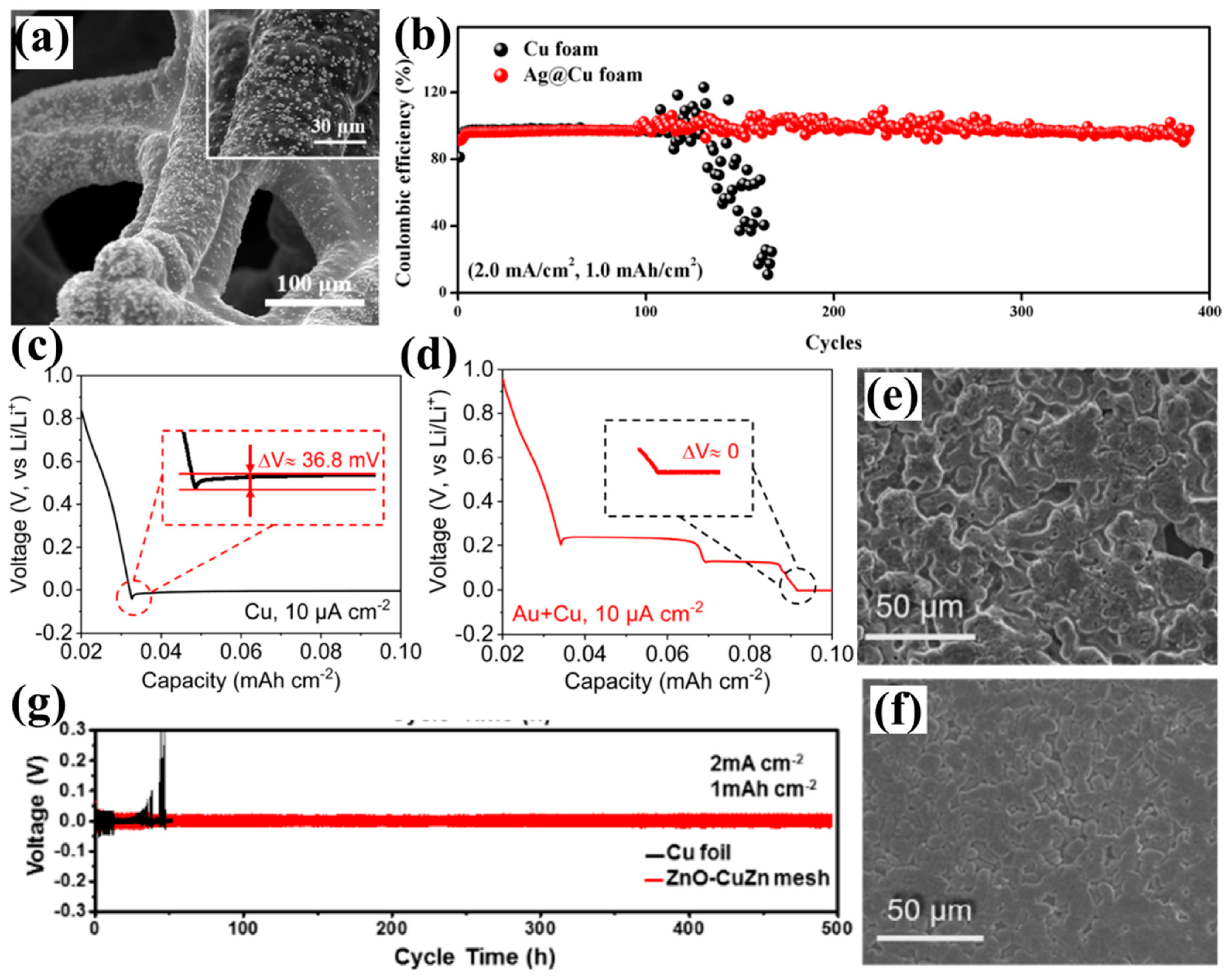
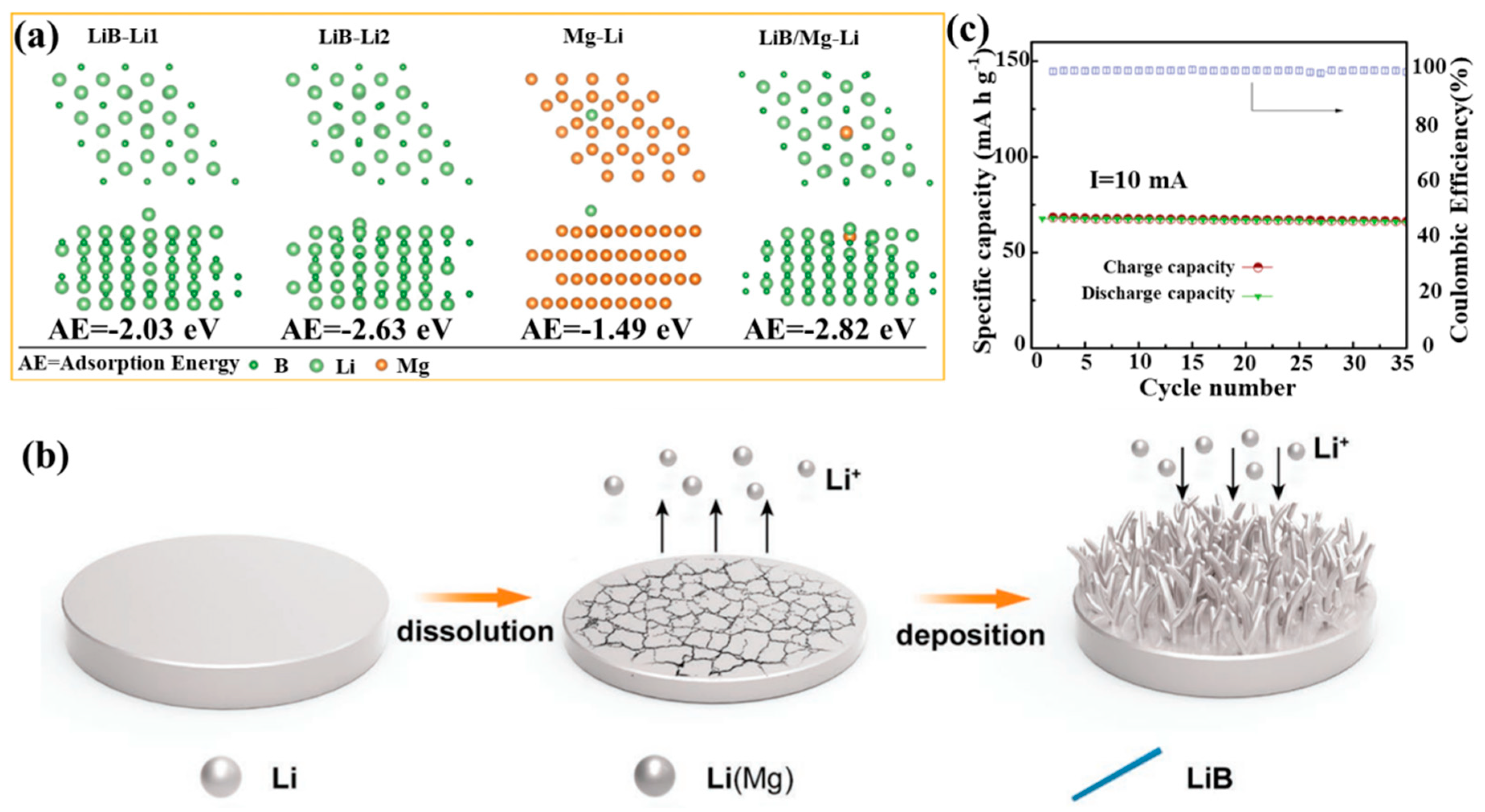
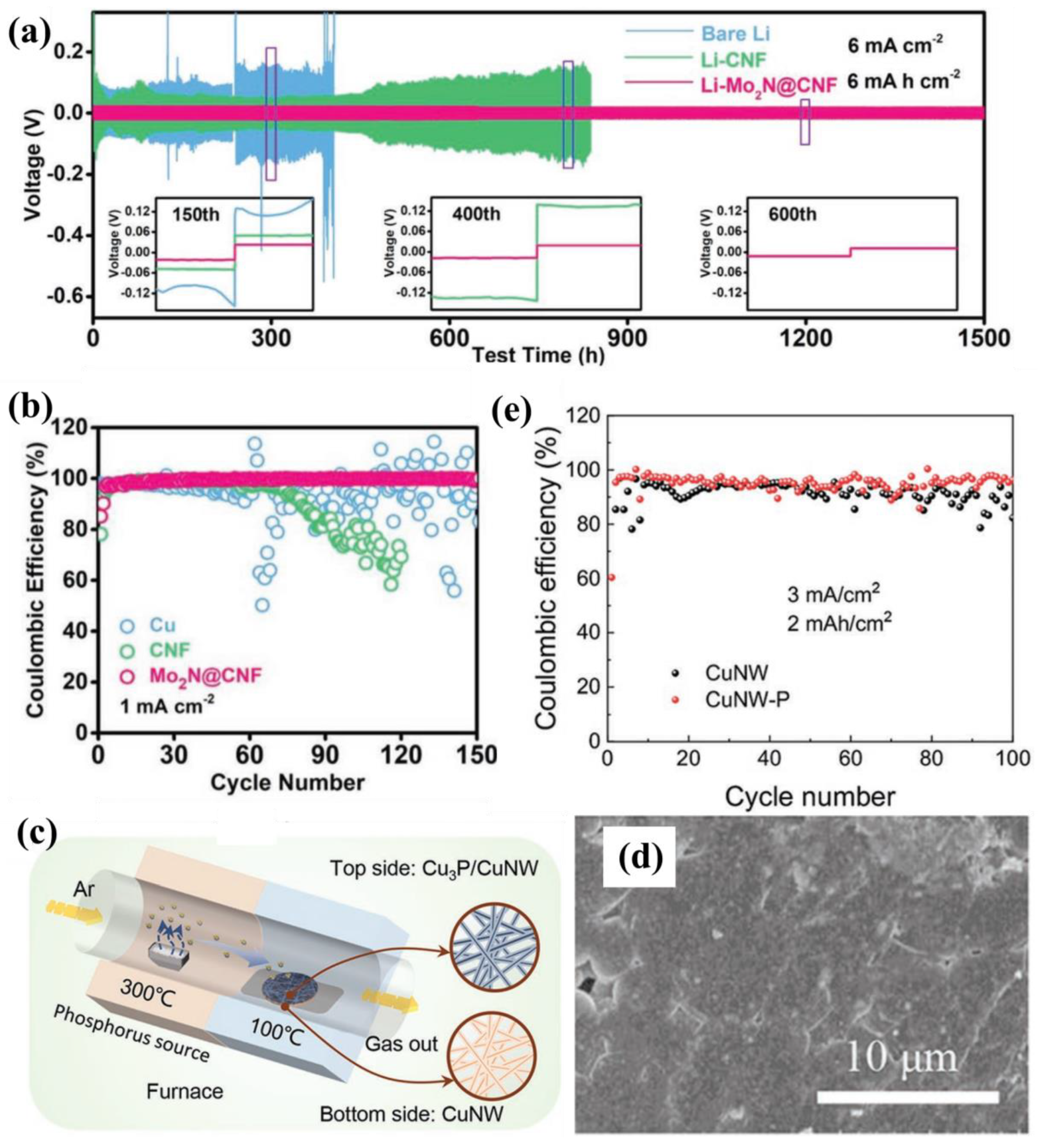

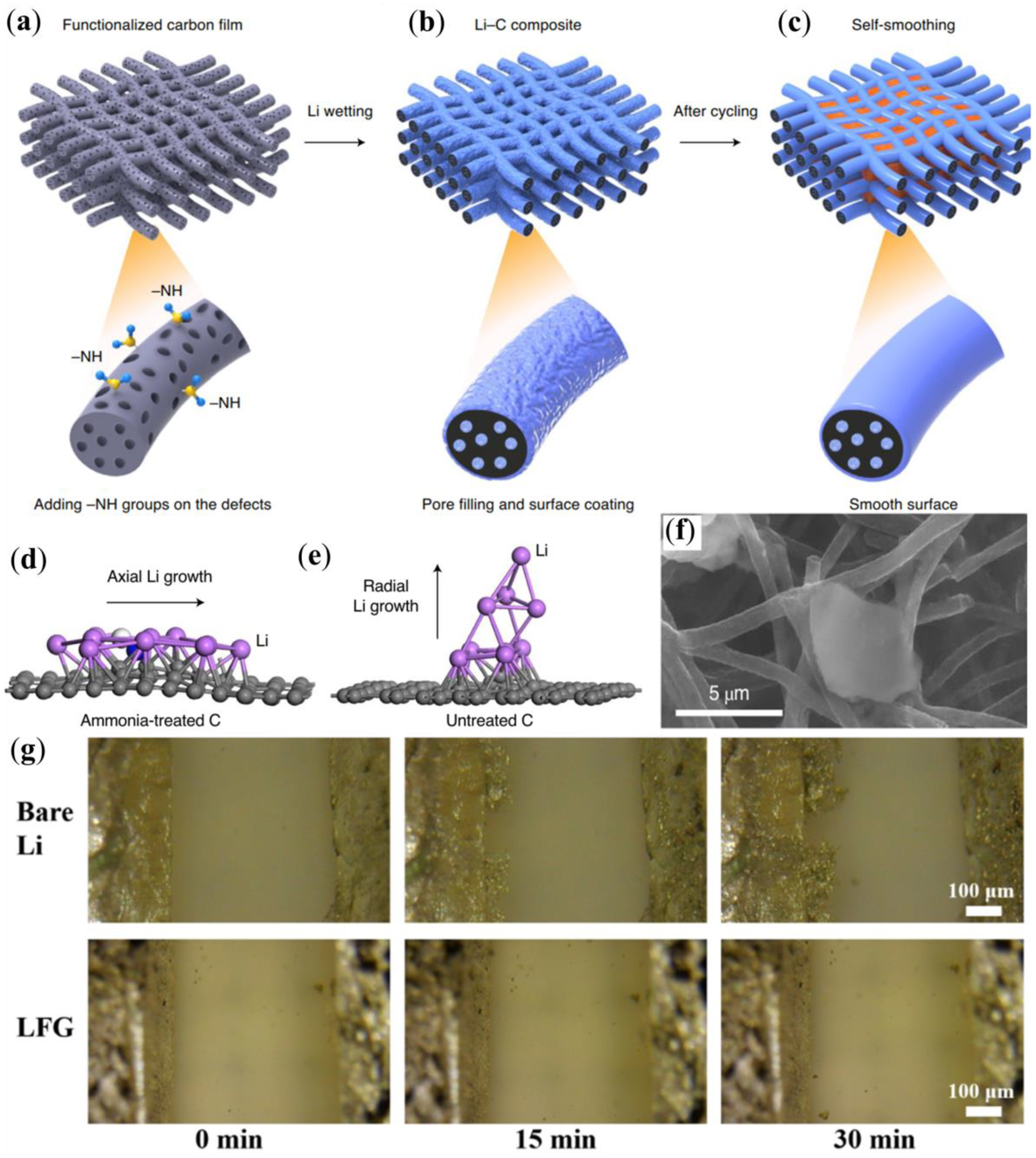
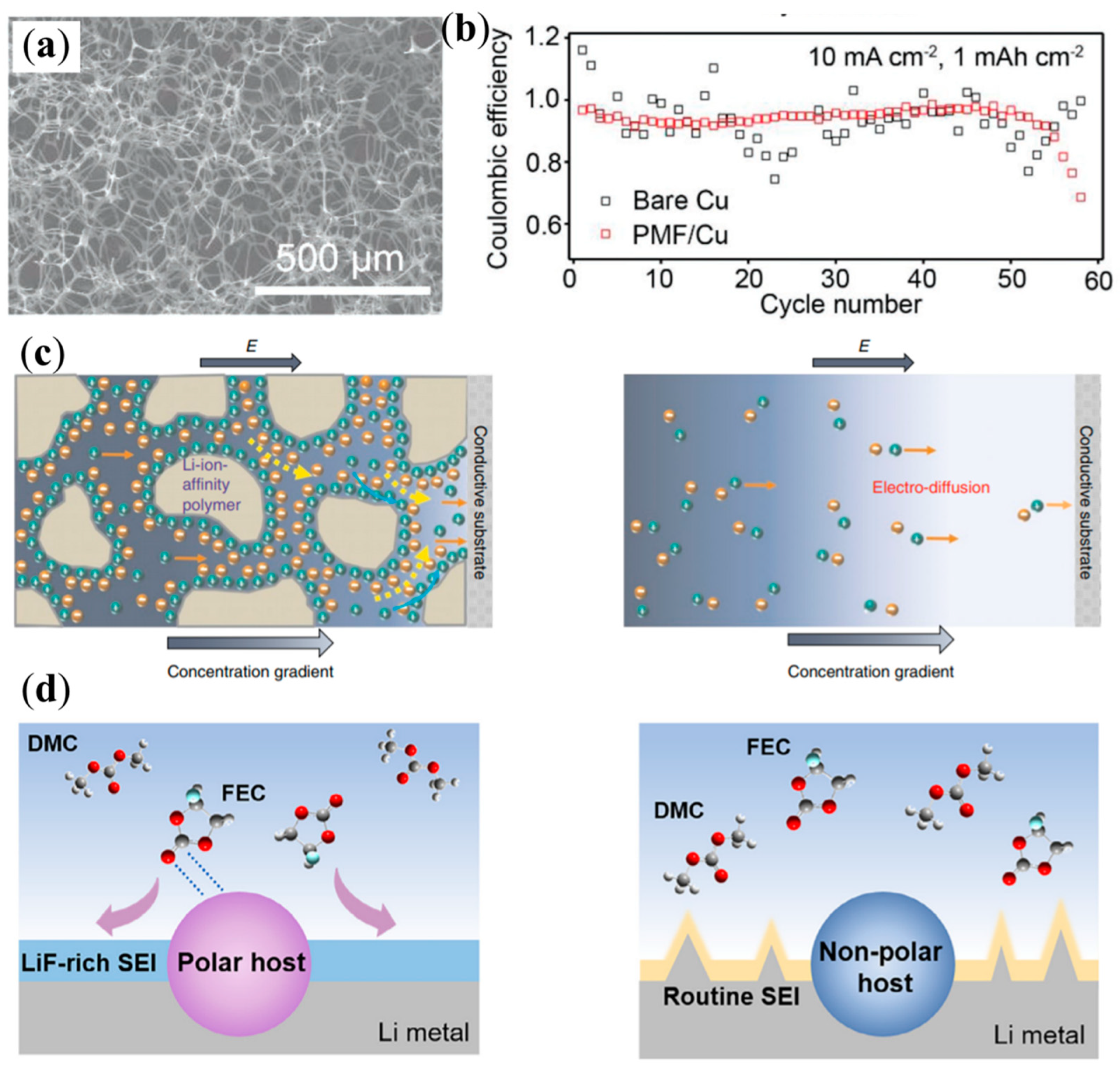
Disclaimer/Publisher’s Note: The statements, opinions and data contained in all publications are solely those of the individual author(s) and contributor(s) and not of MDPI and/or the editor(s). MDPI and/or the editor(s) disclaim responsibility for any injury to people or property resulting from any ideas, methods, instructions or products referred to in the content. |
© 2022 by the authors. Licensee MDPI, Basel, Switzerland. This article is an open access article distributed under the terms and conditions of the Creative Commons Attribution (CC BY) license (https://creativecommons.org/licenses/by/4.0/).
Share and Cite
Yang, Z.; Ruan, Q.; Xiong, Y.; Gu, X. Highly Stable Lithium Metal Anode Constructed by Three-Dimensional Lithiophilic Materials. Batteries 2023, 9, 30. https://doi.org/10.3390/batteries9010030
Yang Z, Ruan Q, Xiong Y, Gu X. Highly Stable Lithium Metal Anode Constructed by Three-Dimensional Lithiophilic Materials. Batteries. 2023; 9(1):30. https://doi.org/10.3390/batteries9010030
Chicago/Turabian StyleYang, Zhehan, Qingling Ruan, Yi Xiong, and Xingxing Gu. 2023. "Highly Stable Lithium Metal Anode Constructed by Three-Dimensional Lithiophilic Materials" Batteries 9, no. 1: 30. https://doi.org/10.3390/batteries9010030
APA StyleYang, Z., Ruan, Q., Xiong, Y., & Gu, X. (2023). Highly Stable Lithium Metal Anode Constructed by Three-Dimensional Lithiophilic Materials. Batteries, 9(1), 30. https://doi.org/10.3390/batteries9010030







